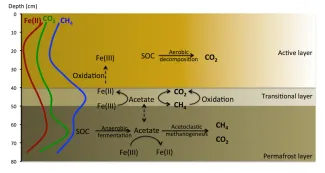Because of the opposing processes of methane (CH4) production and oxidation, it is highly uncertain whether soils in high-latitude ecosystems will function as a source or sink for this important greenhouse gas. To gain insights into these processes, ORNL Postdoc Jianqiu Zheng, David Graham, and others investigated CH4 oxidation potential from degraded polygons on the Barrow Environmental Observatory (BEO), Barrow AK, USA. Soil cores from Flat and High centered polygons were sectioned into active, transitional and permafrost layers based on observed degree of organic matter decomposition, visual evidence of cryoturbation, and measured Fe(II) concentrations. Methanogenesis and CH4 oxidation rates of each soil layer were determined at -2, +4, and +8°C. Significant CH4 oxidation was observed from the transitional and permafrost layers of a flat-centered polygon, which also exhibited higher CH4 production rates during anoxic incubations. Although methanogenesis showed higher temperature sensitivity than CH4 oxidation, rates of CH4 oxidation exceeded methanogenesis rates at each temperature. The zone with the highest CH4 oxidation potential is located close to the oxic/anoxic interface with high methanogenesis activities and could offset CH4 production and limit surface CH4 emissions.
[[{"fid":"180","view_mode":"default","type":"media","link_text":null,"attributes":{"title":"Figure 1. Conceptual model of aerobic and anaerobic soil organic carbon decomposition pathways, Fe(II), CO2 and CH4 concentration profiles in a flat-centered polygon. The spatial correlation between methanogenesis and methane oxidation potential indicates","height":"550","width":"1031","class":"media-element file-default"}}]]
Figure 1. Conceptual model of aerobic and anaerobic soil organic carbon decomposition pathways, Fe(II), CO2 and CH4 concentration profiles in a flat-centered polygon. The spatial correlation between methanogenesis and methane oxidation potential indicates that small changes in the water table and redox gradients could rapidly affect net CH4 emissions.
Figure 1. Conceptual model of aerobic and anaerobic soil organic carbon decomposition pathways, Fe(II), CO2 and CH4 concentration profiles in a flat-centered polygon. The spatial correlation between methanogenesis and methane oxidation potential indicates that small changes in the water table and re
For more information, please contact:
David Graham
grahamde@ornl.gov

